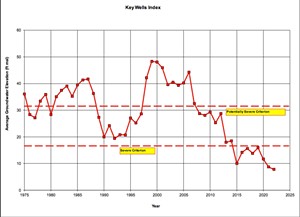Nipomo groundwater is facing its lowest levels in history, and the basin’s facing severe water shortage conditions for the eighth consecutive year.

Despite this, the Nipomo Community Services District (NCSD) will continue planning for the Dana Reserve development, a 1,289 single- and multi-family unit housing project with a focus on injecting more housing into the local market, according to previous Sun reporting.
According to the Dana Reserve’s environmental impact report, the NCSD has sufficient water supply to serve the project with between 538 and 1,205 acre-feet per year of available water.
District General Manager Mario Iglesias said the project will actually help replenish groundwater supply through wastewater treatment. Nipomo imports water from the city of Santa Maria to reduce groundwater reliance, something that happened after a lawsuit was filed in 1997 over a depression forming on the Nipomo Mesa.
“A community is only as good as its water supply. Take away the water supply, and it’s a ghost town. We need to make sure the basin is sustained and managed so it will be there now and in the future,” he continued.
The Dana Reserve would rely on water imported from Santa Maria, and would also help recharge Nipomo’s groundwater basin through a wastewater recycling plan. The Nipomo Mesa Management Area Technical Group can then run its eight wells with the minimum amount needed in order to keep them functioning, Iglesias said.
“The district is trying to import more water because when we put that water into homes on the sewer system, it’s used in the house, sent back into the system, treated in our wastewater treatment plant, and then circled back into the basin to recharge the basin. Our objective is to balance our needs, the community’s needs, and the basin’s ability to yield,” he explained.
The NCSD doesn’t have jurisdiction over all groundwater use from the basin, such as that of agriculture, which would require additional litigation to restrict, Iglesias said.
“Ag users have interest—if there’s no water to grow, their land is deserted land—but they’re not compelled by the courts. We have a specific set of marching orders,” he added.
Several environmental and community organizations voiced concerns over the Dana Reserve’s impact on water resources. Coastal San Luis Conservation District Executive Director Jackie Crabb wrote to the district, questioning the district’s claim about groundwater replenishment through wastewater treatment.
“The Nipomo groundwater basin has been declining for years and is considered to be in serious overdraft. We believe that further evaluation of the ultimate fate of water imported for the project is prudent and in the best interests of the Nipomo community,” Crabb said.
Conservation District President Neil Havlik also sent letter, adding that there’s “considerable uncertainty” about water availability in the Nipomo Mesa area, highlighting the decrease over the years.
“Local measurements have shown a decline in the groundwater table on the Mesa over the past 10 years, and imported water may or may not be able to stem or reverse this decline, if such water will in fact be available in the future,” Havlik said. “For this and other reasons, we request a detailed and independent analysis of the current status of the Nipomo Mesa area’s water supply, past issues, historical trends, future prospects (especially in the event of continued drought), and how the proposed project will affect those matters.”


